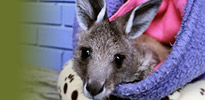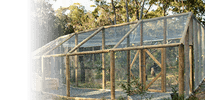What to do if you find a orphaned or injured animal
Most native animals brought to the Department of Primary Industries and Water or Parks and Wildlife Service & Wildlife Carers are by members of the public, are victims of vehicle or window collisions, dog or cat attack, trapping, shooting or electrocution. Our goal is to relieve the stress of these unfortunate animals and ideally to rehabilitate them back to the wild in a fit condition. These notes have been designed to give the animal a better chance of survival during short term care or in an emergency. Long term care requires greater knowledge of an animal's requirements.
Before Capture
Before attempting capture, observe the animal for any signs of illness or injury. Information can then be passed on to an expert to help identify the animal's problem. For example, a broken wing will hang, and an inclined head may suggest concussion or a damaged ear. Look for wounds, unusual behaviour, movements or posture such as lopsidedness.
Capture and Transport
Prepare a suitable transport box for the animal before attempting capture. Cardboard boxes will need airholes punched into them and can be slippery for birds. Line the bottom of the box with newspaper, old towels or an old blanket.
The capture and handling of wild animals can be very stressful (for both animal and handler). Animals can become aggressive and difficult to handle when scared or injured. They may try to defend themselves with wings, teeth, beak or claws. Wear gloves for protection.
A confident yet gentle approach is best. At least two people are needed for the capture of larger animals such as an adult wallaby. If you are inexperienced at handling wildlife or do not have any rescue gear please do not attempt to capture the animal, instead seek expert help.
Most animals can be captured by throwing an old towel or blanket over them. Nets can cause more injuries. Wrap the animal securely or place it in a clean hessian sack or pillowslip and tie off the open end. Do not try and comfort it. Next place the animal and bag into the prepared box or pet pak. Reptiles and echidnas are best scooped into and transported in large plastic garbage bins.
Keep the animal warm and quiet until you can get it home or get advice on its care. Do not allow the animal to be continually disturbed by people wishing to look at it.
Seek expert advice, either by phone or in person, from a veterinarian or the Parks and Wildlife Service. The very fact that you managed to catch the animal usually indicates that something is wrong with it. The Parks and Wildlife Service has few funds available for treating injured wildlife, and these are generally reserved for rare species. Therefore, if you have an animal treated by a vet, you may be responsible for the cost (please ask your vet first).




